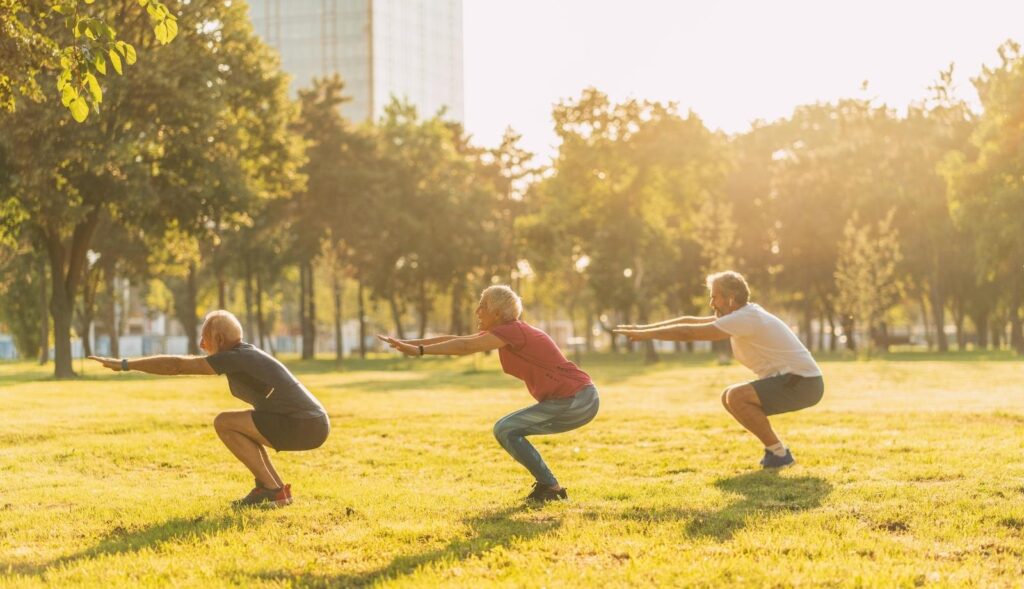Do your knees hurt walking downhill? Can you touch your toes? Can you twist your body to look behind you? These are all functional movements your body is designed to perform easily. And yet, they are difficult and painful for many people.
You may find yourself avoiding exercise because basic movements you perform every day cause pain and the idea of bending over to lace up your trainers, going for a run or a HIIT workout is unappealing.
General advice would suggest if something caused pain, you should stop doing it, but in the case of these basic movements, avoiding them can drastically impact your overall health.
Learning how to use your muscles, bones, and tendons to pull, push, sit, lunge, bend, twist and walk is vital for ensuring strength and mobility as you age.
The mechanics of body movement
Living a life without movement means a very challenging life. The basic movements performed automatically every day make it possible to get you from place to place, sit down and even put food in your mouth. You probably don’t give this much thought until pain tells you something is wrong or walking, sitting or bending becomes difficult.
Your bones give your body shape, your spine, head, arms, legs, hands and feet. This boney frame is useless on its own. Between your bones are joints in various forms. Hinge, ball and socket, and pivotal joints enable you to move your bones up and down and around so you can perform basic functional movements.
Joints cannot move on their own. This is where muscles come in. They contract, relax, lengthen and shorten so you can perform the necessary movements. A change in position only happens if the muscles are attached to the bones by ligaments and tendons.
Now your fundamental anatomy is in place, you need something to tell the muscles in all parts of your body to move. Your brain sends signals via the nerves to the muscle cells, informing them on what they need to do. Every movement involves multiple nerve signals coordinating the contraction and relaxation of your muscles, to move your bones in order to move.
The definition of functional movement
In 2013 the American Physical Therapy Association House of Delegates put forward a vision statement referring to functional movement1:
“Transforming society by optimising movement to improve the human experience.”
‘Functional movement’ refers to the ability to move your body, as it was designed to. When bones, joints, and muscles are perfectly aligned and functioning optimally, you can perform basic movements easily and without pain.
However, when muscles are weak, joints are inadequately supported, or bones are malformed, basic movements can’t be performed normally, causing injury and pain. This may look like painful knees, the inability to lift your arm above your head, or you need support when you sit down in your favourite chair.
Physical therapists can perform a screening test to assess how your body moves. During the assessment, they will ask you to perform specific movements to evaluate how your body moves, including:
- Squat
- Lunge
- Push
- Pull
- Hip-hinge
- Twist or rotate
- Gait or walking
They are looking for how your body compensates for inefficiencies in the movements. For example, do you need to lean forwards when you squat? They are also interested in limits to your range of motion, such as being unable to touch your toes. And do you have asymmetrical movement patterns where one side is stronger than the other?2
The benefits of moving easily
If something causes you pain, you feel less inclined to do it. When daily movements are the reason for your pain, regular exercise becomes unlikely. Therefore, teaching your body how to move well is essential for your health.
While the overall health benefits of exercise are widely known, what may not be so commonly known is the requirement of all types of exercise such as cardiovascular, strength and flexibility, in order to create good functional movement habits, increase range of motion, equally develop muscles and prevent injury.
Lacking in good functional movement habits and or decreased range of motion, may lead you to miss out on the overall health benefits of regular exercise.4
These include:
- Reduced stress, anxiety and depression
- Increased self-confidence and self-image
- Improved cognitive health
- Strong bones and muscles
- Reduced risk of heart disease and diabetes
- A balanced and healthy weight
Your health and well-being are positively influenced by daily physical exercise.
Your body enjoys movement, provided you have learnt to execute movement the way it was designed to be done.
Functional training for easy pain-free movement
When it comes to functional movement, the more you repeat the correct movement, the more natural the movement becomes.
Functional training is purposeful training, working muscles in coordinated multi-directional movement patterns, incorporating more than one joint and group of muscles. Additionally, functional exercise encourages movement and consistent alterations in your posture-supporting muscles to improve overall function. In a “Systematic review of functional training on muscle strength, physical functioning, and activities of daily living in older adults”, functional training is defined as:5
“Any type of training performed with purpose to enhance a certain movement or activity.”
With this definition in mind, the purpose of a workout to improve functional movement is to train the muscles to move easily with a natural, smooth motion which does not cause pain.
The movements you perform in everyday life typically involve more than one muscle group. For example, even standing engages the neck, back, abdominal, hip, leg, and foot muscles. When you twist around to look behind you, the muscles need to adjust in order to help you perform the movement and to maintain balance. A functional workout will do the same thing: engage your whole body in the exercises.
A functional workout includes exercises such as:
- Squats
- Push-ups
- Lunges
- Steps
- Walking
- Plank
- Deadlifts
- Rotations
- Pulling movements such as rowing
You will be familiar with most of these movements if you regularly do a workout. Exercises such as resistance training, circuit workouts, cardio, walking and jogging all require you to move your body using your natural range of motion.
Yoga, pilates, and tai chi add some balance to your exercise routine, strengthening your core muscles and using your bodyweight to build stronger muscles. They also involve stretching the muscles to improve your range of motion.
Move easily and without pain with functional movement
Your body is designed to move easily and without pain. So, when your knees hurt walking down the hill, or your hips are too tight for you to bend over and touch your toes, it is a signal something isn’t right.
All daily movements involve multiple bones, joints, and muscles that must be intricately coordinated to work effectively. If the bone is malformed, the joint is injured, or the muscles are weak, movement is impaired, or your body has to compensate to correct it. The result is pain and stiffness interfering with basic movements such as standing up, walking, or twisting to see what’s behind you.
Easy, pain-free movement is one of the pillars of living a healthy, stress-free life. Let us help you improve your functional movements and gain strength and fitness. Your physical and mental health will benefit too.
References
- Cook G, Burton L, Hoogenboom BJ, Voight M. Functional Movement Screening: The use of Fundamental movements an assessment of function – Part 1. International Journal of Sports Physical Therapy [Internet]. 2014 May [cited 2022 Aug 25]; Available from: https://www.ncbi.nlm.nih.gov/pmc/articles/PMC4060319/?report=classic
- Clark SC, Rowe ND, Adnan M, Brown SM, Mulcahey MK. Effective Interventions for Improving Functional Movement Screen Scores Among “High-Risk” Athletes: A Systematic Review. International Journal of Sports Physical Therapy [Internet]. 2022 Feb 1 [cited 2022 Aug 25];(2). Available from: http://dx.doi.org/10.26603/001c.31001
- Elmagd MA. Benefits, need and importance of daily exercise. International Journal of Physical Education, Sports and Health [Internet]. 2016 [cited 2022 Aug 25]; Available from: http://www.kheljournal.com/archives/2016/vol3issue5/PartA/3-4-55-201.pdf
- Benefits of Exercise: MedlinePlus [Internet]. MedlinePlus – Health Information from the National Library of Medicine. [cited 2022 Aug 25]. Available from: https://medlineplus.gov/benefitsofexercise.html
- Liu C, Shiroy DM, Jones LY, Clark DO. Systematic review of functional training on muscle strength, physical functioning, and activities of daily living in older adults. European Review of Aging and Physical Activity [Internet]. 2014 Aug 30 [cited 2022 Aug 26];(2):95–106. Available from: http://dx.doi.org/10.1007/s11556-014-0144-1





